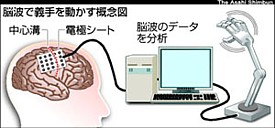
Honda has developed new brain-machine interface (BMI) technology that allows humans to control the Asimo humanoid robot simply by thinking certain thoughts.
The BMI system, which Honda developed along with Advanced Telecommunications Research Institute International (ATR) and Shimadzu Corporation, consists of a sensor-laden helmet that measures the user's brain activity and a computer that analyzes the thought patterns and relays them as wireless commands to the robot. (Watch video.)
When the user simply thinks about moving his or her right hand, the pre-programmed Asimo responds several seconds later by raising its right arm. Likewise, Asimo lifts its left arm when the person thinks about moving their left hand, it begins to walk when the person thinks about moving their legs, and it holds its hand up in front of its mouth when the person thinks about moving their tongue.
 The high-precision BMI technology relies on three different types of brain activity measurements. EEG (electroencephalography) sensors measure the slight fluctuations in electrical potential on the scalp that occur when thinking, while NIRS (near-infrared spectroscopy) sensors measure changes in cerebral blood flow. Newly developed information extraction technology is used to process the complex data from these two types of sensors, resulting in a more accurate reading. The system reportedly has an accuracy rate of more than 90%.
The high-precision BMI technology relies on three different types of brain activity measurements. EEG (electroencephalography) sensors measure the slight fluctuations in electrical potential on the scalp that occur when thinking, while NIRS (near-infrared spectroscopy) sensors measure changes in cerebral blood flow. Newly developed information extraction technology is used to process the complex data from these two types of sensors, resulting in a more accurate reading. The system reportedly has an accuracy rate of more than 90%.
The use of EEG and NIRS sensors makes the new system more compact than previous BMI systems that rely on bulkier fMRI (functional magnetic resonance imaging) technology. Although the system is small enough to be transported from place to place, the developers plan to further reduce the size.
Honda, which has been conducting BMI research and development with ATR since 2005, is looking into the possibility of one day using this type of interface technology with artificial intelligence and robotics to create devices that users can operate without having to move.
[Source: Honda press release]

 Your gain, my pain? New research from Japan shows that the human brain treats feelings of envy like physical pain, while schadenfreude -- the pleasure derived from another person's misfortune -- triggers the brain's reward circuits. The findings, published in the February 13 online edition of
Your gain, my pain? New research from Japan shows that the human brain treats feelings of envy like physical pain, while schadenfreude -- the pleasure derived from another person's misfortune -- triggers the brain's reward circuits. The findings, published in the February 13 online edition of 
 As Japanese consumers become ever more "
As Japanese consumers become ever more " Researchers at Osaka University are stepping up efforts to develop robotic body parts controlled by thought, by placing electrode sheets directly on the surface of the brain. Led by Osaka University Medical School neurosurgery professor Toshiki Yoshimine, the research marks Japan's first foray into invasive (i.e. requiring open-skull surgery) brain-machine interface research on human test subjects. The aim of the research is to develop real-time mind-controlled robotic limbs for the disabled, according to an announcement made at an April 16 symposium in Aichi prefecture.
Researchers at Osaka University are stepping up efforts to develop robotic body parts controlled by thought, by placing electrode sheets directly on the surface of the brain. Led by Osaka University Medical School neurosurgery professor Toshiki Yoshimine, the research marks Japan's first foray into invasive (i.e. requiring open-skull surgery) brain-machine interface research on human test subjects. The aim of the research is to develop real-time mind-controlled robotic limbs for the disabled, according to an announcement made at an April 16 symposium in Aichi prefecture.  In an effort to accelerate the development of next-generation automobiles and robots, Toyota is turning to some of Japan's top neuroscientists. According to a December 14 announcement, the automaker has teamed up with the Institute of Physical and Chemical Research (
In an effort to accelerate the development of next-generation automobiles and robots, Toyota is turning to some of Japan's top neuroscientists. According to a December 14 announcement, the automaker has teamed up with the Institute of Physical and Chemical Research ( A team of University of Tokyo researchers led by professors Hitoshi Sakano and Ko Kobayakawa have announced they have genetically engineered a mouse that does not fear cats, simply by controlling its sense of smell. By tweaking genes to disable certain functions of the
A team of University of Tokyo researchers led by professors Hitoshi Sakano and Ko Kobayakawa have announced they have genetically engineered a mouse that does not fear cats, simply by controlling its sense of smell. By tweaking genes to disable certain functions of the 
